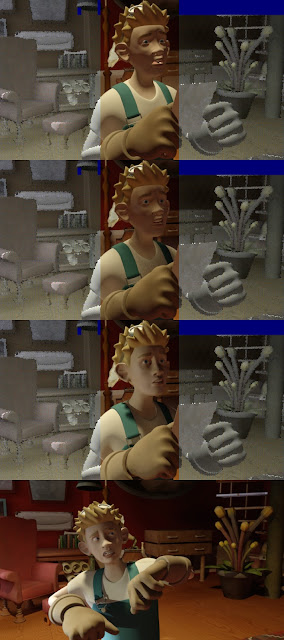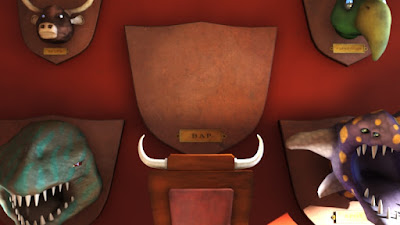A Literature Review of Chapter 4: Immersion
From Janet H. Murray's Hamlet on the Holodeck. (1999, The MIT Press)
Janet H. Murray's book on interactive narrative art form, and where she sees it developing, is an insight into the potential of storytelling in all kinds of interactive media including videogames, hyperlink fiction, and interactive TV. Though the book is twelve years old and even some of it's more conservative predictions have yet to manifest in any of the formats mentioned above, while others are just starting to emerge on the cutting edge of interactive storytelling.
 In this chapter the author outlines the quality of immersion offered by the fictional holodeck of Star Trek and other more readily available platforms. She begins by creating some context and framing the progress of the narrative art form with a quote from Don Quixote, which holds a warning of the fictional realities presented in books and their hold over an individual's imagination. This enticing promise of an immersive virtual reality is present in many media and Murray states this with comparisons to theme park rides and “thrilling movies” (Murray, 1999: 98)
In this chapter the author outlines the quality of immersion offered by the fictional holodeck of Star Trek and other more readily available platforms. She begins by creating some context and framing the progress of the narrative art form with a quote from Don Quixote, which holds a warning of the fictional realities presented in books and their hold over an individual's imagination. This enticing promise of an immersive virtual reality is present in many media and Murray states this with comparisons to theme park rides and “thrilling movies” (Murray, 1999: 98)The addictive and alluring properties of experiencing an immersive story is programmed into our brains according to Murray. She emphasizes the attractive nature of these experiences through lust orientated semantics like “the age old desire to live out a fantasy aroused by a fictional world” (1999: 98) and “the pleasurable surrender of the mind to an imaginative world” (1999: 110). These technique appears throughout the entire chapter to varying effect depending on your disposal towards the kind of narrative experiences she describes which are wide ranging and well related.
Murray goes on to talk about the metaphorical meaning of immersion as opposed to its literal meaning, and how its relevant to understanding its effect on the audience in an interactive story. She compares the experience of psychological immersion to that of swimming in water. The difference being that with a videogame, and it's unique set of mechanics and systems, the player has to learn how to swim each time they dive into a new experience which makes the interactive process of learning unique to videogame immersion. In this way the player becomes integrated into the way the world itself works quite rapidly when done correctly. Her use of water based metaphor continues as she describes a similar phenomenon in other media like music and television and then concludes the information heavy introduction to the chapter with the summary of “This chapter is about such digital swimming” (1999: 99) bringing the paragraph to a close with style and good use of repetition.
 The liminal state between realities is then discussed and introduces psychological terminology and applies it to fictional realities in an attempt to better explain how this transition between states is made by the player or audience. The authors use of the fourth wall as technique to enhance or break immersion does well to illustrate how immersion is so “inherently fragile” (1999: 100) and its effect can different even from person to person within an audience, she cites an account from James Barrie as an example.
The liminal state between realities is then discussed and introduces psychological terminology and applies it to fictional realities in an attempt to better explain how this transition between states is made by the player or audience. The authors use of the fourth wall as technique to enhance or break immersion does well to illustrate how immersion is so “inherently fragile” (1999: 100) and its effect can different even from person to person within an audience, she cites an account from James Barrie as an example.Avatars, hyper-realism, perpetual existence of a virtual world, and interaction are all techniques Murray states enhance immersion through out the rest of the chapter. She even references Windsor McCay's Gertie as some of the earliest interactive animation giving the writing historical credibility. While the chapter isn't always as coherent as a reader might like, it definitely succeeds in relating the methods of immersion unique to interactive storytelling in an informed and enthusiastic manner.
I spent some time practising that highest of arts during the holidays: colouring in! Noel Paisley is nearly finished, I haven't yet finished shading him. I found my method has come to mimic that of render passes, I have an ink layer, then colour, tone, and often these are further broken up into face, body, arms etc.
 | |
| Noel Paisley |
I've continued work as much as I can with The Last Trophy and being back its really good to finally see the characters lit. As I'd only been working with the environments before, there were some problems to sort out once the characters were imported. Here are some examples of the tweaks I've been making:
 |
| Shadows turned on (and changed from depthmap to raytrace) to darken the mouth, lights repositioned to fake sunlight. |
 |
| Surround lights turned on plus shadows, light repositioned to mimic sun. |
Pixel Propaganda
Why Duke Nuk'em annoys the hell out of me, hint: similar reasons to that of Bulletstorm.
An interesting take on the effects of ludo narrative dissonance in Red Dead Redemption, and how the player can derive meaning from fighting the game's authorial and idealogical hand.
I always love the Contrarian Corner articles, and though Dragon Age doesn't interest me, this piece makes some good points, and made me laugh.
While the extent to which a war shooter should aim for realism remains questionable, I downloaded the high quality version of this trailer and couldn't stop thinking, this is real. Not just in terms of graphical fidelity but also the character animation is gorgeous.



